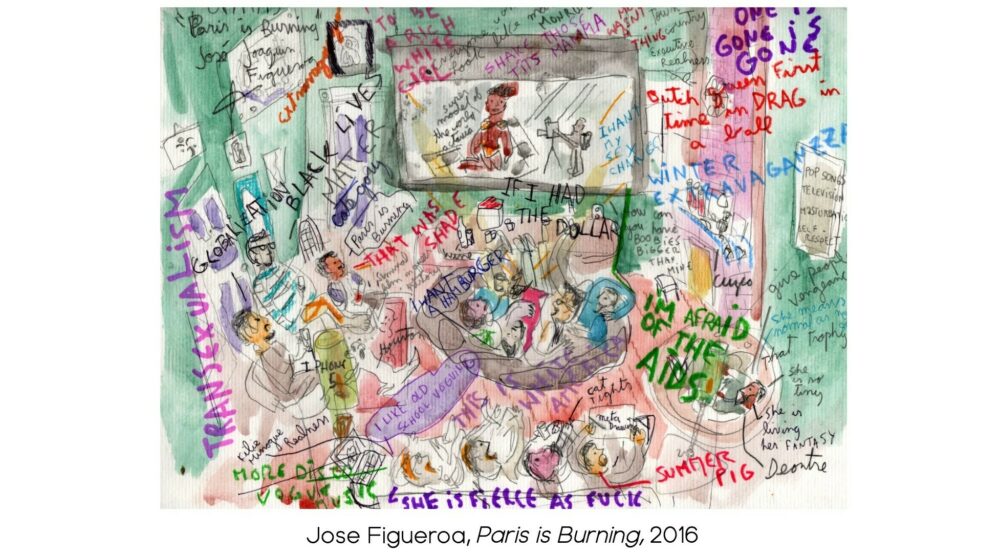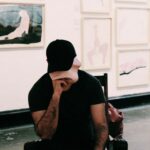




































featured gallery for April 2022
“I AM AFRAID OF THE AIDS”

The title, “I AM AFRAID OF THE AIDS,” comes from Paris is Burning, a drawing by the Venezuelan-born and Oakland-based artist Jose Figueroa. The picture, part of a more extensive series of work emerging from the artist’s everyday life and encounters, depicts a gathering of queer friends watching the 1990 documentary, Paris is Burning, at Figueroa’s house. Various quotes and statements from the film or comments made by the audience overlap the image. I AM AFRAID OF THE AIDS is in bold green text on the bottom right-hand corner of the drawing, and it is unclear from the surrounding words whether the statement, if said out loud, resulted in a further discussion.
Extending the drawing, where a group of queer folx look at history from various individual points of view, I unpack the stigma around HIV / AIDS. Approaching the Visual AIDS archive as a non-Western person of color, I center Black, Indigenous, and People of Color (BIPOC) narratives. In doing so, I hope my engagement will lead to more comprehensive critical discussions on the topic, broaden visual representations of BIPOC artists living with HIV / AIDS, and acknowledge the contributions of those who died of HIV / AIDS-related complications.
The web gallery features artworks by Reza Abdoh, Sunil Gupta, Affrekka Jefferson, Rotimi Fani-Kayode, Tatiana Mazur, Abdul-Aliy A. Muhammad, and the Keiskamma Art Project.
“AIDS LA ILLAJ HAI” (Translation: AIDS is not curable)
Apart from Carol Willick and Charles Bing, two problematically depicted lesbian and gay characters in the American TV show Friends (1994 - 2004), growing up in Pakistan in the 1990s, I had few explicit exposures to LGBTIQ2S+ representation in visual culture. Even though there were state-level efforts to address the HIV / AIDS epidemic after the country's first diagnosis in 1986, my only memory on the topic is an advertisement I saw on TV. I recall silhouettes of a heterosexual couple sitting on a sofa in the ad. They slowly approach each other to touch their hands, suggesting unprotected sexual contact outside marriage. The screen then cuts to a text with a voiceover, "AIDS LA ILLAJ HAI," which translates as AIDS is not curable in the Urdu language. I suspect I was seven when I saw the ad, and the intended shock-value had a clear impact on my mind.
I moved to London, UK, at 19 for art school. Though some sex education and advice was provided to the new students during the induction week, upon reflection, I feel it was not enough for those who had no prior knowledge on the subject in their home countries. At the time, my exposures were conservative and limited; and I struggled with a long history of sexual abuse and coming to terms with my sexuality. In Pakistan, while I had always felt different due to my queerness, it was in London I felt othered in foreign ways. My Pakistani and South Asian (hairy) body and Muslim cultural background became explicit and pronounced when immersed in a sea of white torsos at gay nightclubs. During my first sexual encounter in London, I didn't use protection. I was just happy to be noticed and go home with someone. A friend explained how risque that was and took me to the Sexual Health Clinic the following morning. At the clinic, they told me how prevalent HIV / AIDS was in the city and that I should take Post-exposure Prophylaxis (PEP). Unfortunately, in 2007, the side effects of taking the drug were still quite intense, and from the first day, my body started to experience extreme diarrhea and vomiting. To control these symptoms, I received more medications.
Alongside the physical effects of PEP, the psychological impact was also too much. Despite once-a-week sessions with a sexual health counselor, I felt traumatized and abandoned the medication a week into the four-week course. As required, I continued to get tested and was relieved to be HIV negative, but my relationship with sexuality further deteriorated, and I did not have sex again for a long time. Occasionally, when I tried, parts of my body would go icy cold, and I would start shivering; I later learned this was my body remembering trauma and fear.
Over the years, my journey has involved: seeking consistent mental health support and alternative healing practices, learning about and engaging with LGBTIQ2S+ history, and building queer communities of color in Pakistan and beyond. As a consequence of these efforts, I have also developed a more accepting and liberated relationship with my sexuality, started processing the trauma and shame I carried, and shedding and combating the negative messages I internalized around HIV / AIDS.
Looking back, I am confident that my life and experience of sexuality would have been very different if I had early access to diverse LGBTIQ2S+ perspectives and the messaging around HIV / AIDS was not so violent. A wish that I also see echoed in Derrick Woods-Morrow and Charan Singh's work.
Derrick Woods-Morrow, Much Handled Things Are Always Soft, 2019. Commissioned by Visual AIDS for STILL BEGINNING: The 30th Annual Day With(out) Art.
Charan Singh, Sideways, 2020. Commissioned by Visual AIDS for Day With(out) Art 2020: TRANSMISSIONS.
Acquired Dread of Sex (ADS)
Four decades since the first reporting of HIV / AIDS cases, there is still a long way to tackle the stigma, prejudice, and misconceptions associated with the condition. Despite recent advancements in HIV / AIDS healthcare and medication, even in the so-called Global North, where legal systems and visual representations are supposedly more open, people living with HIV / AIDS experience many challenges. Shehab Isis Awad, curator of the No Fucks Given gallery (Dec 2021 - Jan 2022), notes, "People, like me, who live with an undetectable level of HIV in their body still face sexual stigma, regardless of the CDC's declaration in 2017 that an undetectable person has "effectively no risk" of transmitting the virus to sexual partners." Those at the forefront of the discourse have long known and actively called out the homophobic roots of how governments and society have addressed the HIV / AIDS epidemic. Many artists have also played an important role here. From a very early point in history, they were already tackling the issues head-on, in ingenious, creative, and hysterical ways - for example, The ADS Epidemic, a 1987 video work by artist and activist John Greyson. In the 5-minute short remake of Luchino Visconti's Death in Venice, Greyson takes a satirical approach to respond to the problematic framing of HIV / AIDS as a gay disease, changing the cholera epidemic to the Acquired Dread of Sex (ADS) epidemic and a plague of bigots.
John Greyson, The ADS Epidemic, 1987. Courtesy of V tape.
Over time, as public discourse and artistic contributions on HIV / AIDS and its history have increased, the contributions of BIPOC artists, who died of HIV / AIDS-related complications or are living with HIV / AIDS, remain under-discussed in the field. In addition to making art that directly addressed the AIDS crisis, many of these artists also radically approach aesthetic traditions, push the disciplinary boundaries of their media and address intersectional issues on queerness and race. We are just starting to see some of these artists get the institutional recognition they long deserved. Amongst them is Reza Abdoh (1963–1995), who was an Iranian-born American theater director and playwright. The first large-scale retrospective of his spectacular and impressive body of work took place at the MoMA PS1 in 2018. The exhibition, which included a range of video works by Abdoh from the early 1990s, highlighted his complex, experimental, and avant-garde aesthetic language, which combined various influences, such as fairy tales, BSDM, and club culture.
Similarly, the London, UK-based Indian-Canadian artist Sunil Gupta (b. 1953) has actively maintained a photographic practice that spans five decades. When looked at collectively, his work acts as a powerful living archive of the gay liberation movement on Christopher Street in the late 1970s, his cultural and migratory identities as a South Asian gay man - navigating multiple geographic locations and living with HIV. Yet, he is only starting to get international acclaim now with shows at The Photographers' Gallery, London (2020) and his retrospective at the Ryerson Image Centre, Toronto (2022).
Conclusion
As a result, when approaching the Visual AIDS database, I have intended to honor the history and memory of BIPOC artists who died of HIV / AIDS-related complications, recognizing their place in the movement. Furthermore, given that the conversation on HIV / AIDS is ongoing and current, I also included artists living with HIV and a community project from South Africa. The latter also demonstrates the importance of addressing HIV / AIDS from a global perspective, particularly taking into account non-Western contexts.
When selecting the artists, I also noticed gaps in the archive, particularly around the representation of and information on BIPOC women, trans, and non-binary artists. Hence, it is important to note that this web gallery is, by no means, a definitive survey of BIPOC artists who died with HIV / AIDS-related complications or are living with HIV / AIDS. Instead, I hope this presentation becomes an invitation to expand BIPOC perspectives on the subject further while working toward a world where no one has to be afraid of "the AIDS."
